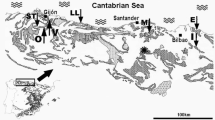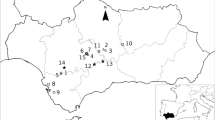Abstract
The Frasassi cave system in central Italy hosts one of the few known examples of a groundwater metazoan community that is supported by sulfur-based lithoautotrophic microbes. Despite the challenging conditions represented by high concentrations of H2S and low concentrations of O2, this cave system is home to many invertebrate species. Here, we analyzed the copepods inhabiting sulfidic lakes and non-sulfidic dripping pools in order to investigate how environmental conditions in sulfidic waters regulate the spatial distribution of the cave microcrustacean community over time. We also sampled copepod assemblages of sulfidic lakes under conditions of both high and low H2S concentration. Cluster analysis and canonical correspondence analysis separated the copepod assemblages inhabiting dripping pools from those of sulfidic lakes. H2S concentration, pH and O2 concentration were identified as the main factors regulating community structure. These results indicate that the distribution of groundwater copepods within the cave system is ecologically and spatially structured. Sulfidic lakes showed lower Simpson dominance, higher Shannon diversity and higher Pielou equitability at higher H2S concentrations. The complex community structure of the copepods of the Frasassi cave system suggests that a chemosynthetically produced food source facilitated the colonization of stygobionts in sulfidic groundwater due to their tolerance to the environmental conditions.






Similar content being viewed by others
References
Baselga A (2010) Partitioning the turnover and nestedness components of beta diversity. Global Ecol Biogeogr 19:134–143
Bauermeister J, Ramette A, Dattagupta S (2012) Repeatedly evolved host-specific ectosymbioses between sulfur-oxidizing bacteria and amphipods living in a cave ecosystem. PLoS One 7:e50254. doi:10.1371/journal.pone.0050254
Bauermeister J, Assig K, Dattagupta S (2013) Exploring the sulfide tolerance of ectosymbiotic Niphargus amphipods from the Frasassi caves, central Italy. Int J Speleol 42:141–145. doi:10.5038/1827-806X.42.2.6
Bodon M, Cianfanelli S (2012) Il genere Islamia Radoman, 1973, nell’Italia centro-settentrionale (Gastropoda: Hydrobiidae). Boll Malacol 48:1–37
Cocchioni M, Galdenzi S, Amici V, Morichetti L, Nacciarriti L (2003) Studio idrochimico delle acque nelle Grotte di Frasassi. Grotte Ital 4:49–61
Dattagupta S, Schaperdoth I, Montanari A, Mariani S, Kita N, Valley JW, Macalady JL (2009) A recently evolved symbiosis between chemoautotrophic bacteria and a cave-dwelling amphipod. ISME J 3:935–943
Di Lorenzo T, Galassi DMP (2013) Agricultural impacts on Mediterranean alluvial aquifers: do invertebrates respond? Fundam Appl Limnol 182:271–281
Di Lorenzo T, Di Marzio WD, Spigoli D, Baratti M, Messana G, Cannicci S, Galassi DMP (2014) Metabolic rates of a hypogean and an epigean species of copepod in an alluvial aquifer. Freshw Biol 60:426–435
Engel AS (2007) Observations on the biodiversity of sulfidic karst habitats. J Cave Karst Stud 69:187–206
Engel AS (2012) Chemoautotrophy. In: Culver DC, White WB (eds) Encyclopedia of caves, 2nd edn. Elsevier Academic Press, San Diego, pp 125–134
Engel AS, Lee N, Porter ML, Stern LA, Bennett PC, Wagner M (2003) Filamentous “Epsilonproteobacteria” dominate microbial mats from sulfidic cave springs. Appl Environ Microbiol 69:5503–5511
Engel AS, Stern LA, Bennett PC (2004) Microbial contributions to cave formation: new insights into sulfuric acid speleogenesis. Geology 32:269–372
Fattorini S (2010) Effects of fire on tenebrionid communities of a Pinus pinea plantation: a case study in a Mediterranean site. Biodiv Conserv 9:1237–1250
Fattorini S (2011) Influence of island geography, age and landscape on species composition in different animal groups. J Biogeogr 38:1318–1329
Fišer C, Luštrik R, Sarbu S, Flot J-F, Trontelj P (2015) Morphological evolution of coexisting amphipod species pairs from sulfidic caves suggests competitive interactions and character displacement, but no environmental filtering and convergence. PLoS One 10:e0123535. doi:10.1371/journal.pone.0123535
Flot JF, Wörheide G, Dattagupta S (2010) Unsuspected diversity of Niphargus amphipods in the chemoautotrophic cave ecosystem of Frasassi, central Italy. BMC Evol Biol 10:171. doi:10.1186/1471-2148-10-171
Forti P, Galdenzi S, Sarbu SM (2002) The hypogenic caves: a powerful tool for the study of seeps and their environmental effects. Cont Shelf Res 22:2373–2386
Galassi DMP (2001) Groundwater copepods (Crustacea: Copepoda): diversity patterns over ecological and evolutionary scales. Hydrobiologia 453(454):227–253
Galassi DMP, De Laurentiis P (2004) Little-known cyclopoids from groundwater in Italy: re-validation of Acanthocyclops agamus and redescription of Speocyclops italicus (Crustacea, Copepoda, Cyclopoida). Vie Milieu 54:203–222
Galassi DMP, Dole-Olivier M-J, De Laurentiis P (1999) Phylogeny and biogeography of the genus Pseudectinosoma, and the description of P. janineae sp. n. (Crustacea: Copepoda, Ectinosomatidae). Zool Scr 28:289–303
Galassi DMP, Lombardo P, Fiasca B, Di Cioccio A, Di Lorenzo T, Petitta M, Di Carlo P (2014) Earthquakes trigger the loss of groundwater biodiversity. Sci Rep. doi:10.1038/srep06273
Galdenzi S (2012) Corrosion of limestone tablets in sulfidic ground-water: measurements and speleogenetic implications. Int J Speleol 4:149–159. doi:10.5038/1827-806X.41.2.3
Galdenzi S, Menichetti M (1995) Occurrence of hypogenic caves in a karst region: examples from central Italy. Environ Geol 26:39–47
Galdenzi S, Cocchioni M, Morichetti L, Amici V, Scuri S (2008) Sulfidic ground-water chemistry in the Frasassi caves, Italy. J Cave Karst Stud 70:94–107
Grieshaber MK, Völkel S (1998) Animal adaptations for tolerance and exploitation of poisonous sulfide. Annu Rev Physiol 60:33–53
Hammer Ø, Harper DAT, Ryan PD (2001) PAST: paleontological statistics software package for education and data analysis. Palaeontol Electron 4:1–9
Hayek LC, Buzas MA (2010) Surveying natural populations. Quantitative tools for assessing biodiversity. Columbia University Press, New York
Hill MO, Gauch HG (1980) Detrended correspondence analysis, an improved ordination technique. Vegetatio 42:47–58
Jones DS, Tobler DJ, Schaperdoth I, Mainiero M, Macalady JL (2010) Community structure of subsurface biofilms in the thermal sulfidic caves of Acquasanta Terme, Italy. Appl Environ Microbiol 76:5902–5910. doi:10.1128/AEM.00647-10
Jones DS, Polerecky L, Galdenzi S, Dempsey BA, Macalady JL (2015) Fate of sulfide in the Frasassi cave system and implications for sulfuric acid speleogenesis. Chem Geol 410:21–27
Klaus S, Mendoza JCE, Liew JH, Plath M, Meier R, Yeo DCJ (2016) Rapid evolution of troglomorphic characters suggests selection rather than neutral mutation as a driver of eye reduction in cave crabs. Biol Lett 9:20121098. doi:10.1098/rsbl.2012.1098
Lawniczak M, Romestaing C, Roussel D, Maazouzi C, Renault D, Hervant F (2013) Preventive antioxidant responses to extreme oxygen level fluctuation in a subterranean crustacean. Comp Biochem Physiol A Mol Integr Physiol 165:299–303
Lee NM, Meisinger DB, Aubrecht R, Kovacik L, Saiz-Jimenez C, Baskar S, Baskar R, Liebl W, Porter ML, Engel AS (2012) Caves and karst environments. In: Bell EM (ed) Life at extremes: environments, organisms and strategies for survival. CAB International, London, pp 320–344
Macalady JL, Lyon EH, Koffman B, Albertson LK, Meyer K, Galdenzi S, Mariani S (2006) Dominant microbial populations in limestone-corroding stream biofilms, Frasassi cave system, Italy. Appl Environ Microbiol 72:5596–5609
Macalady JL, Dattagupta S, Schaperdoth I, Jones DS, Druschel GK, Eastman D (2008) Niche differentiation among sulfur-oxidizing bacterial populations in cave waters. ISME J 2:590–601
Magurran AE (1988) Ecological diversity and its measurements. Princeton University, Princeton
Magurran AE (2004) Measuring biological diversity. Blackwell Publishing, Malden
Malard F, Hervant F (1999) Oxygen supply and the adaptations of animals in groundwater. Freshw Biol 41:1–30
Mariani S, Mainiero M, Barchi M, Van Der Borg K, Vonhof H, Montanari A (2007) Use of speleologic data to evaluate Holocene uplifting and tilting: an example from the Frasassi anticline (northeastern Apennines, Italy). Earth Planet Sci Lett 257:313–328
Marrone F, Stoch F, Galassi DMP (2011) Discovery of a stygobiotic population of the epigean diaptomid calanoid Eudiaptomus intermedius (Steuer, 1897) in Central Italy. In: 11th international conference on Copepoda, Mérida, Mexico, vol 2011, p 79
Meleg IN, Battes KP, Fiers F, Moldovan OT (2015) Contrasting copepod community dynamics related to sampling strategies in the unsaturated zone of a karst aquifer. Aquat Ecol 49:549–560. doi:10.1007/s10452-015-9545-0
Peterson DE, Finger KL, Iepure S, Mariani S, Montanari A, Namiotko T (2013) Ostracod assemblages in the Frasassi Caves and adjacent sulfidic spring and Sentino River in the northeastern Apennines of Italy. J Cave Karst Stud 75:11–27. doi:10.4311/2011PA0230
Por FD (2007) Ophel: a groundwater biome based on chemoautotrophic resources. The global significance of the Ayyalon cave finds, Israel. Hydrobiologia 592:1–10
Por FD, Dimentman Ch, Frumkin A, Naaman I (2013) Animal life in the chemoautotrophic ecosystem of the hypogenic groundwater cave of Ayyalon (Israel): a summing up. Sci Res 5:7–13. doi:10.4236/ns.2013.54A002
Sarbu SM (2000) Movile cave: a chemoautotrophically based groundwater ecosystem. In: Wilkens H, Culver DC, Humphreys WF (eds) Subterranean ecosystems. Elsevier, Amsterdam, pp 319–343
Sarbu SM, Kane TC, Kinkle BK (1996) A chemoautotrophically based cave ecosystem. Science 272:1953–1955
Sarbu SM, Galdenzi S, Menichetti M, Gentile G (2000) Geology and biology of the Frasassi caves in central Italy: an ecological multi-disciplinary study of a hypogenic underground karst system. In: Wilkens H, Culver DC, Humphreys WF (eds) Subterranean ecosystems. Elsevier Science, Amsterdam, pp 359–378
Somero GN, Childress JJ, Anderson AE (1989) Transport, metabolism, and detoxification of hydrogen sulfide in animals from sulfide-rich marine environments. Crit Rev Aquat Sci 1:591–614
ter Braak CJF, Prentice IC (1988) A theory of gradient analysis. Adv Ecol Res 18:271–317
ter Braak CJF, Smilauer P (2002) CANOCO reference manual and CanoDraw for windows user’s guide. Software for canonical community ordination (version 4.5). Microcomputer Power, Ithaca NY, p 500
Tyson RV, Pearson TH (1991) Modern and ancient continental shelf anoxia: an overview. In: Tyson RV, Pearson TH (eds) Modern and ancient continental Shelf Anoxia. Geological Society Special Publication No. 58, London, pp 1–24
Acknowledgments
The Project was partially funded by the European Community (LIFE12 BIO/IT/000231 AQUALIFE). We are indebted to Simone Cerioni of the Speleological Group of Genga, Maurizio Mainiero of the Marche Speleological Group of Ancona, Samuele Carnevali of the Gruppo Speleologico of Fabriano, and Maxwell Montanari of the OGC for technical support in the sampling campaigns. Financial support is also acknowledged for speleological equipment and laboratory materials for preliminary analyses and sample preparation provided by the Observatorio Geologico di Coldigioco (OGC). We are also grateful to the Georg-August-Universität Göttingen, Göttingen, Germany (Sharmishtha Dattagupta, Linn Groeneveld, Nicolas Cerveau, Mahesh Desai, Jean-François Flot, Jan Bauermeister) and the IMDEA Water Institute, Alcala de Henares, Madrid, Spain (Sanda Iepure) for providing us with chemical data. We are also grateful to two anonymous referees for their helpful suggestions.
Author information
Authors and Affiliations
Corresponding author
Additional information
Handling Editor: Michael T. Monaghan.
Electronic supplementary material
Below is the link to the electronic supplementary material.
Rights and permissions
About this article
Cite this article
Galassi, D.M.P., Fiasca, B., Di Lorenzo, T. et al. Groundwater biodiversity in a chemoautotrophic cave ecosystem: how geochemistry regulates microcrustacean community structure. Aquat Ecol 51, 75–90 (2017). https://doi.org/10.1007/s10452-016-9599-7
Received:
Accepted:
Published:
Issue Date:
DOI: https://doi.org/10.1007/s10452-016-9599-7




